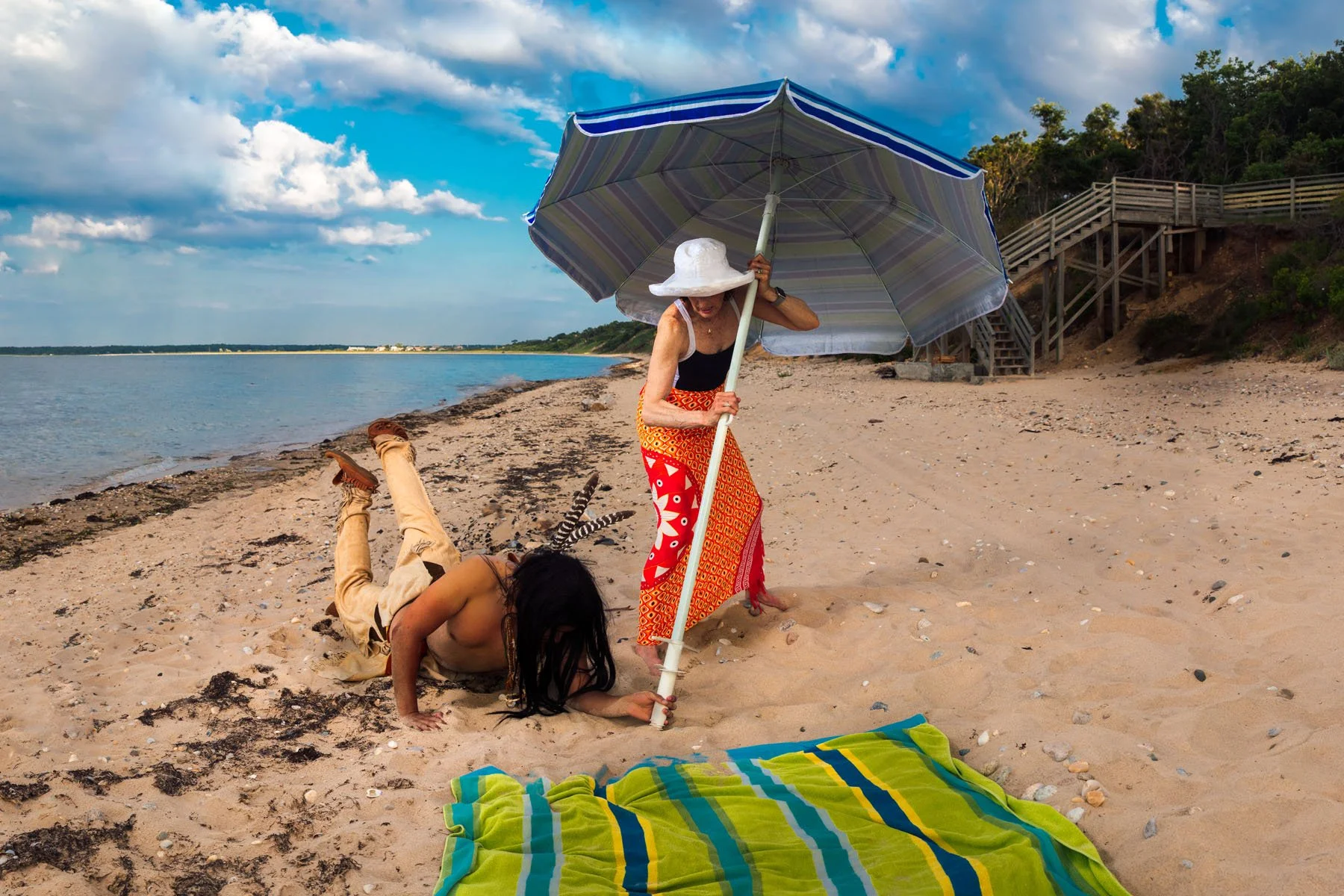‘Works on Water’ from Jeremy Dennis’ Lens
Photographer Jeremy Dennis discusses his work in the exhibition presented by the Lower Manhattan Cultural Council.
Native Guide, 2021. Photography by Jeremy Dennis
For its third edition, the Works on Water Triennial returns with over two dozen international artists presented by the Lower Manhattan Cultural Council. Curatorial Directors Emily Blumenfeld and Kendal Henry tapped these artists to go beyond their artistic practices: utilizing water as a medium, material, site, and collaborator.
On view through October 26 at The Arts Center at Governors Island, the exhibition includes interactive and thought-provoking site-specific installations, performances, workshops, and immersive experiences. Artists confront our daily dependence on water and its impact on climate change, colonialism, and the role of technology.
For Jeremy Dennis, a Shinnecock Indian Nation photographer, landback movements such as the Occupation of Wounded Knee and the Dakota Access Pipeline (DAPL) Water Protectors are centered around his Rise photograph series. Due to the climate crisis rapidly changing the Shinnecock shoreline, Dennis’ urgency throughout the eerie yet humorous photo series hones in on reclaiming the beach.
Dennis spoke with 1202 MAGAZINE about his Indigenous connection to working with water, themes he incorporates in his photography to convey his messages, and his experience participating in Works on Water.
Walking Past, 2019. Photography by Jeremy Dennis
Could you describe some of the photos and the messages they convey at the Works on Water exhibition?
The photographs I’m showing are from my Rise series, where I stage scenes on the shoreline—figures submerged, rising out of the surf, or reclaiming the beach as Shinnecock space. On the surface, the images might look eerie or humorous, but that’s intentional. Humor is my way of filtering some cumbersome conversations about belonging, landback, and who gets to control access to water and land.
The Shinnecock have lived with and cared for this coastline for over 12,000 years, but today we have to pay to visit our own ancestral beaches. It’s absurd—and the photographs lean into that absurdity, making the contradiction visible while also affirming our resilience. Not only is humor incorporated as a motif, but fear is also present, in reference to scary movies and popular zombie culture. I refer to ideas of resurgence, a supposed vanished race or invisible people reappearing, and how it relates to Indigenous landback movements such as the Occupation of Wounded Knee and DAPL Water Protectors.
A Dream of Neighbors and Evil Spells, 2019. Photography by Jeremy Dennis
What did photographing water teach you as a photographer, and how does it represent you/your culture?
Photographing water taught me to let go of control—because the tide, the wind, and the light are going to do what they want, no matter how much I plan. That unpredictability can be frustrating, but it’s also a gift—it keeps me humble and teaches me to collaborate with nature. For Shinnecock, this is especially meaningful because our very name translates to “people of the stony shore.” Water is foundational to who we are—our foodways, ceremonies, and stories all flow from the shore. So every photograph with water isn’t just an image—it’s a reflection of my community’s identity and survival.
How are these works different from your other bodies of work, but also how does it distinguish that it’s still Jeremy Dennis photography?
These works are different because I’ve given water a central focus—it’s not just a backdrop but a collaborator. Compared to my earlier project, On This Site, which focused more on land-based histories, these works lean into the ocean as both a lifeforce and a contested space. But they’re still unmistakably mine—you’ll see the same cinematic staging, use of props and costumes, and humor that I always bring to my work. Humor, for me, is a tool of survivance, in Gerald Vizenor’s sense—it lets me flip fear and erasure into presence and resistance, while reminding people that Indigenous life is ongoing, not trapped in the past.
I Could Stand Here All Night, 2021. Photography by Jeremy Dennis
Can you tell me about your connection to Works on Water and the climate crisis?
Being part of Works on Water feels urgent because the climate crisis is already reshaping our lives at Shinnecock. Rising seas and coastal erosion threaten our territory as it exists today. It’s not just about losing land—it’s about losing community, culture, and history if we don’t act. That’s why the Landback movement is vital.
As a Nation, we are working to reclaim stolen places like Shinnecock Hills, not just as symbolic gestures, but as a matter of survival. Stewarding our land and waters isn’t optional for us—it’s the foundation of our future. At the same time, being connected to a community of artists who are all making work with and about water is powerful—it reminds me that our struggles and our hopes are interconnected, and that art can help carry these conversations forward in ways that science or policy alone cannot.
Land Claim, 2019. Photography by Jeremy Dennis
Would you continue photographing water? Why or why not?
Yes, absolutely. In fact, even in my On This Site project, which traces ancestral Shinnecock places, the majority of locations are tied to water—whaling camps, fishing grounds, ceremonial sites, and shorelines that carry thousands of years of memory. Water keeps showing up in my work because it keeps showing up in our history. Photographing it allows me to continue telling those stories, while also reminding people that the struggle for access, belonging, and stewardship is still ongoing.





